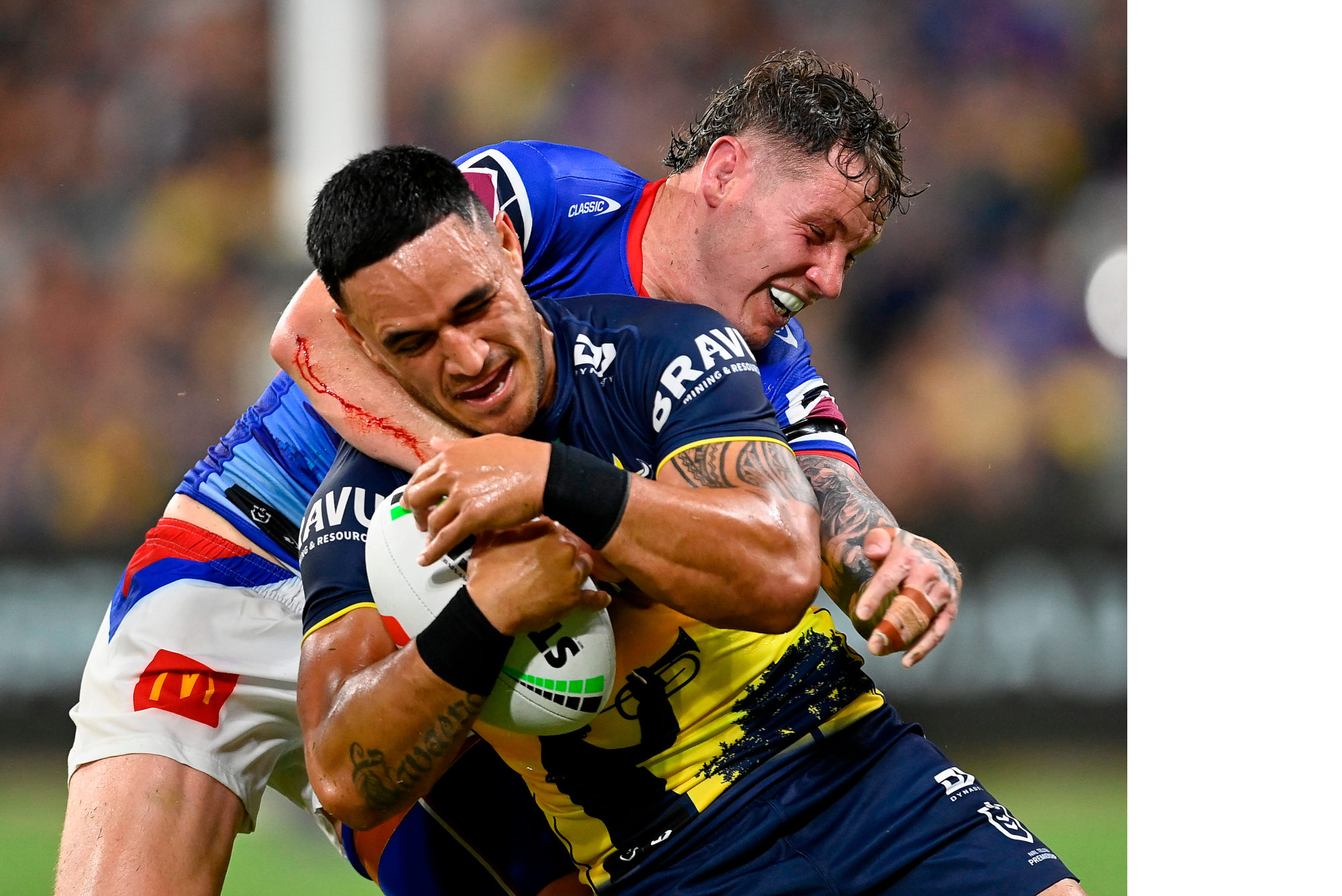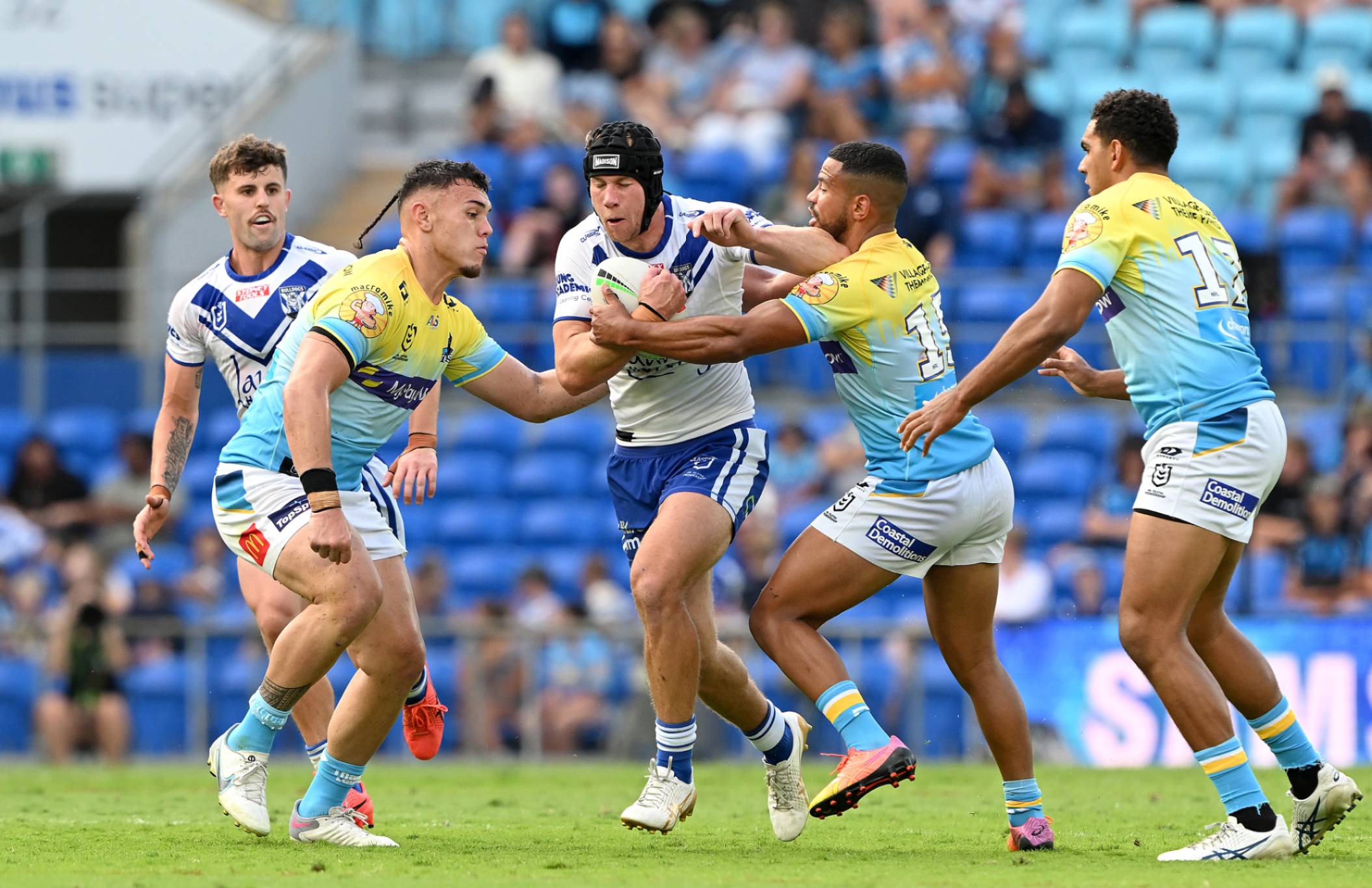Stats can tell you a lot of things in rugby league.
They can give a read on who is the best in which position, or even what sort of player someone is within a certain position.
As anyone who has read this series will know, we like to evaluate players based on key metrics for what they have done in the past and cast forward to suggest what clubs should do to solve key tactical and personnel questions in the future.
Canterbury, however, is where the Good Ship Spreadsheets runs aground.
The Bulldogs have so many selection conundrums that we could run a whole series just on them.
Our Round 1 preview suggested as much, with only their big name four of Matt Burton, Reed Mahoney, Viliame Kikau and Josh Addo-Carr dead certs to start in a specific jumper.
“It’s probably easier to list the ones that are locked in,” it read of the 1-17.
“Burton will be five-eighth, Mahoney at hooker, Kikau on the left edge, Foxx on a wing and everything else up for grabs.”
Since then, circumstances and public pronouncements have transpired to add Toby Sexton at halfback and Jacob Preston at right edge, and the lack of anyone else pretty much ensures that Max King will start in the front row.
On top of that, we know that Jacob Kiraz will definitely be somewhere, but we don’t know if that will be as a winger or a centre.
We know Stephen Crichton will be somewhere, but that could be fullback or centre.
So what, then, of the legion of utilities? How does Cameron Ciraldo fit them all in?
The Doggies’ recruitment this year calls to mine that Pimp My Ride meme: “Yo Dawg, I heard you like utility players so we signed utilities on utilities so you can have utility out of your utility”.
It’s probably the first time early 2000s rapper Xzibit and 1980s rugby league stalwart Phil Gould have been mentioned in the same orbit but hey – consider it What U See Is What U Get meets What You Get Is What You See.
Gould’s signing policy is either leading to a really interesting style of footy that emphasises interchangeability and flexibility in attack or an imbalanced team that lacks front rowers and is overstocked with guys who can do a bit of everything.
From a data perspective, it does make them really hard to work with.

(Photo by Cameron Spencer/Getty Images)
The four utility players they have signed were all predominantly bench options, bit-part players or specialist utilities at their old clubs, thus making them hard to evaluate against each other or, really, anyone else.
Blake Taaffe, for example, was a fullback at Souths when Latrell Mitchell wasn’t available but it would be a big surprise if he started the year there at Canterbury.
Otherwise, he’s a spark plug bench 14 who doesn’t play hooker in a team that already has an 80 minute dummy half.
It would be slightly less surprising if Connor Tracey took the 1 jumper, given he impressed in that role at Cronulla late last year, but again, that was only because the main guy (Will Kennedy in this case) was injured.
Prior to 2023, Tracey had never started a game at fullback ever, even in NSW Cup, but had been an outside back after previously only playing as a half.
Can we compare the two? Sure. Would it be worth it? Probably not, because Crichton almost certainly starts the year there anyway.
To get a read on whether Tracey might start as a centre, where there are spots available following the departures of both Paul Alamoti and Jake Averillo, we’d have to look at data that is a year old and in a totally different system.
Even then, we’d be comparing him to other centre options, such as Kiraz, who has five games from the end of last year and a few of NSW Cup from early 2022, and Bronson Xerri, who hasn’t played NRL in four years after a drug ban.
It’s a pretty pointless exercise, as anything we could derive would be mere speculation, and the task gets even harder when you move up the field.
Drew Hutchison and Jaeman Salmon are both options in the halves, but one spent the last year playing a bit of centre, a bit of bench utility and some 7 while the other has 15 games of five eighth spread over five years in the NRL in between a lot of bench time that reduces any signal with a whole heap of noise.

(Photo by Ian Hitchcock/Getty Images)
Kurt Mann was at least a fairly consistent lock until midway through last year, but that was the first time he’d played there ever, so we can assume it was more of a tactical piece that Newcastle were doing rather than anything permanent.
Before to that experiment in the 13, Mann was an outside back or a playmaker and, as anyone who has seen him knows, he’s about as pure a utility as it gets.
It’s likely that all five utility options will be in the team somewhere come Round 1, because it’s hard to see how they would have moved to Belmore in the first place if not to get more game time.
Instead of looking at the players then, we might do better to look at the 2023 Dogs and see if the individual characteristics of the newcomers will help improve them.
Last year’s Canterbury were horrendous defensively and had to do a lot of it, which is a recipe for disaster.
Their try causes was worst in the comp (by a distance), meaning that someone was responsible for most of the tries they let in.
This wasn’t a failure of execution so much, because missed tackles are a bit of a nonsense stat, rather bad reads that left someone with no tackle to miss.
Fun fact: the Storm, who conceded the fifth fewest points in the comp, had the highest number of missed and ineffective tackles combined, while the Tigers, they of the second worst defence, had the fewest.
When averaged across the number of tackles they were required to make, the Dogs weren’t great, but they were also right next to the Broncos, who went alright last year. Tackle execution stats are a bit of a myth.

Matt Burton. (Photo by Bradley Kanaris/Getty Images)
The biggest two issues, in fact, were lack of defensive organisation and simply that they had so much defending to do.
Organisation certainly isn’t improved by chopping and changing a load of players, but it’s pretty hard to find data to support a counterfactual of keeping a cohesive team.
The Bulldogs used a ridiculous 36 players last year, a league-high in the NRL and almost an entire run-on team more than the most settled side, Cronulla.
A lot of that was down to an injury crisis and then trying things at the end of the year when they were already done, so it can perhaps be fairly passed off as bad luck, and one hopes that 2024 can be more consistent on that front.
We can, however, deep dive into why the Bulldogs ended up with the other team having the ball so frequently.
Completion rates, as long time readers will know, can get in the bin alongside missed tackles and indeed Canterbury are the post child for how dumb a stat it is, as they topped the league for it in a year in which they finished last.
The high completions era Doggies were dull as dishwater to watch, which isn’t something that you could necessarily say about this teams.
Their handling errors were the worst in the NRL per possession, but that needn’t be a bad thing. Souths and the Broncos also rate badly there, and are among the best in attack.
It’s more about where the errors occur. If anything, one can look at the players with the most handling errors in the NRL and despair at the lack of Bulldogs.
The top of that list contains some of the most creative players around, those willing to risk it for the proverbial biscuit.
The middle is a big problem, too, and one that none of the signings solve.
Canterbury’s average sets per game was third last – only the Tigers and Dolphins were worse – and their average metres per set and per run were both second worst, to the Sea Eagles and Dragons respectively.
They struggled to break tackles and were almost last for Off Ball Value, the advanced stat that measures decoys, supports and general attacking deception.

(Photo by Izhar Khan/Getty Images)
These two stats that are not unrelated to each other, because the more men in motion you have, the more the defence has to decide late on whether an attacker will run or pass, increasing the chance that they make an ineffective tackle.
You could throw in that they also had the fewest post-contact metres, which could also be down to the ability of opponents to line up the tackler knowing that they were not going to pass.
If there is a silver lining to the Dogs’ inability to sign a big man to replace their two departing props, Luke Thompson and Tevita Pangai jnr, then it might well be that they can run a very agile attack.
We have a tendency in the NRL to focus on the big boppers, but Cronulla have shown that you can go a very long way without one in your side.
While they struggle against the very best due to a lack of elite middles, that is a problem that Canterbury would kill to have.
If the starting rotation was King, Liam Knight, Ryan Sutton and a host of do-a-job forwards with high energy and decent defence – like, say, Jaeman Salmon, Josh Curran and Kurt Mann – then they could significantly up the activity levels among the pack and generate a lot of supports and deception.
The rules have been trending away from brute strength and towards guys who can get down, get up and do a lot of high-energy work off the ball.
The club have been telling anyone who will listen about their brutal training standards, so one can only hope that brings them to Round 1 in the fitted state possible.
On top of that, much as there was a palaver about the running the gauntlet wrestling session last year, anyone with the slightest knowledge of BJJ will be able to tell you that the whole discipline is designed to equalise size differences on the floor.
If the Dogs have been running and wrestling better than anyone else, there’s a world where they can play a lot of smaller bodied but utilitarian players.
If they do that, then they might end up with a lot of players who can pass, tackle and create in different parts of the field, and who can do it to a high standard for a long time across the game.
This is all theoretical, of course, but it makes the Dogs perhaps the most interesting side to watch going into the trials and the first month. They have to have something up their sleeve – but nobody has a clue what it might be.
































































































